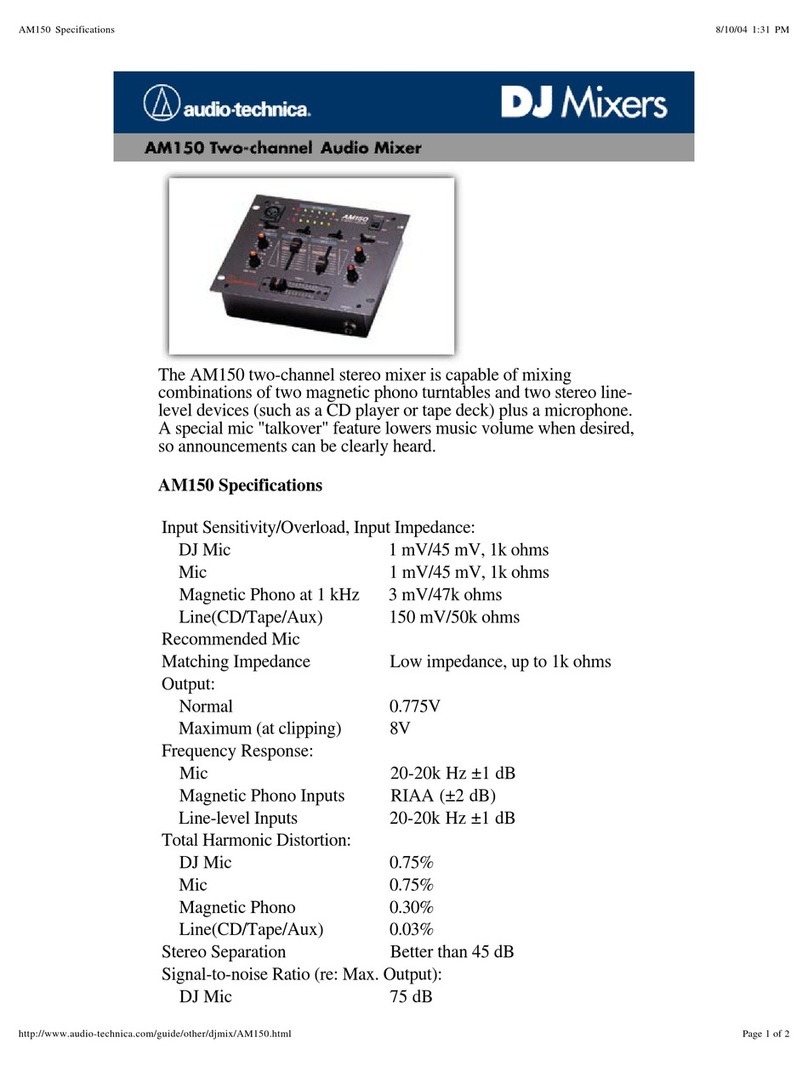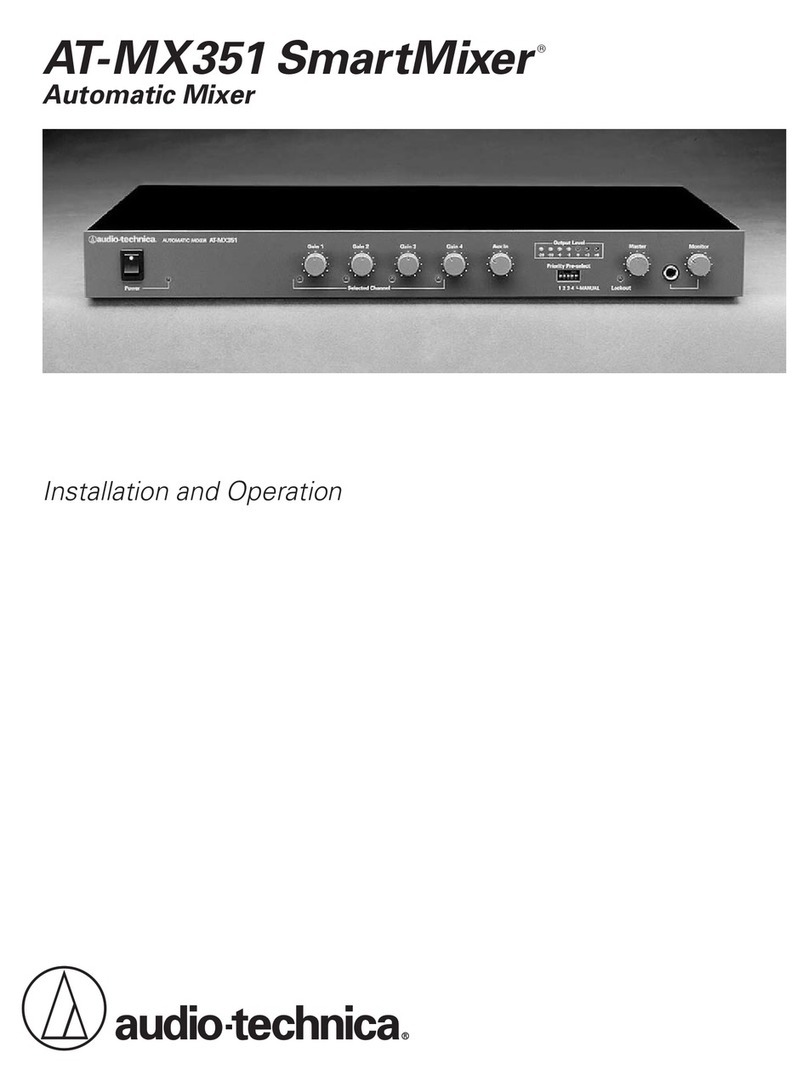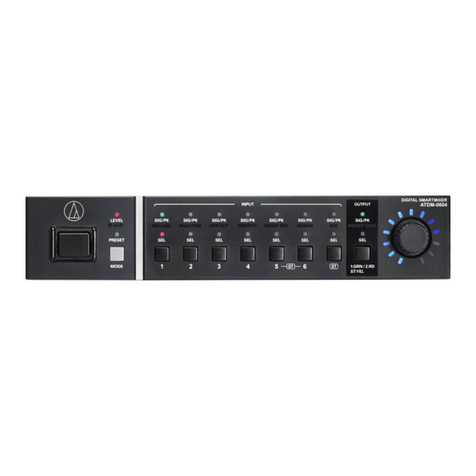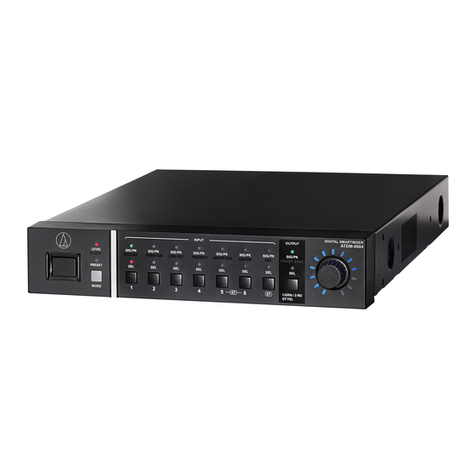
The AT-MX351a SmartMixer®is a microprocessor controlled, automatic switching, five-chan-
nel mixer.
The four microphone inputs are XLRF-type balanced, with 48-volt phantom power available on
pins 2 and 3. The Aux input is an RCA jack accepting auxiliary-level input from external audio
devices. There is no signal processing of the Aux input. The mixer output is XLRM-type
balanced, non-inverting.
All AT-MX351a and AT-MX341 SmartMixers can be daisy-chained via the included
AT8325/1.0 Link Cable and special connectors on the rear panel. The control bus and the
audio are carried between mixers by the link cable. The result is that all microphones on a
multi-mixer system can be controlled by one microphone connected to any mixer. Since all
of the mixers are independently powered, there is no practical limit to the number of
SmartMixers that can be daisy-chained.
TheAT-MX351a provides an independent gain control on the front panel for eachinput chan-
nel. Substantial gain reserve and adjustment range permit microphones of widely differing
sensitivities to be used together successfully. Automatic threshold setting on all mic/line chan-
nels ensures proper gating levels for existing ambient sound conditions.
Priority Pre-select
To custom-tailor conferencing needs, the mode of each microphone channel can be indepen-
dently switched via the front panel “Priority Pre-select” DIP switches. The combination of
switch settings results in three different modes of priority selection/operation.
In any of the three modes of operation, when everyone stops talking, the last microphone “on”
will remain “on.” In a teleconferencing, recording, or broadcast application, this feature will
provide continuous room ambience. This feature is cascaded throughout all linked mixers so
that only one microphone in the entire system will remain on.
When a microphone is “off,” its input is only attenuated. This attenuation is factory set at
8 dB. The amount of “off ” attenuation can be internally adjusted between 6 dB and 40 dB if
desired. (See page 12, “Adjusting ‘Off ’ Attenuation.”)
If automatic switching is not desired, a “manual” DIP-switch setting onthefront panel bypasses
the AT-MX351a’s automatic switching and attenuation functions, causing the unit to behave
like a conventional mixer. In this mode, the relative level of each microphone is strictly a
function of the position of its respective front-panel gain control.
NOMA (Number of Open Microphones Attenuated)
The NOMA system helps control feedback by allowing for the increase in system gain that
occurs when the number of open microphones increases. A built-in matrix in the AT-MX351a
recognizes exactly how many microphones are on and automatically adjusts the gain accord-
ingly. Because use of NOMA is not always appropriate or desired, the AT-MX351a is shipped
with the NOMA function switched off.
Please Note!
This manual assumes use of microphone-level inputs and line-level output, the most typical
SmartMixer application. However, all inputs and the output may be individually switched
internally to achieve anycombination of mic- and line-level input/output. See page 10 for details.
Introduction
What is a SmartMixer®?
Features
5
The AT-MX351a SmartMixer®is a microprocessor controlled, automatic switching, five-channel mixer.
The four microphone inputs are XLRF-type balanced, with 48-volt phantom power available on pins 2
and 3. The Aux input is an RCA jack accepting auxiliary-level input from external audio devices. There is
no signal processing of the Aux input. The mixer output is XLRM-type balanced, non-inverting.
All AT-MX351-model SmartMixers and AT-MX341-model SmartMixers can be daisy-chained via the
included AT8325/1.0 Link Cable and special connectors on the rear panel. The control bus and the audio
are carried between mixers by the link cable. The result is that all microphones on a multi-mixer system
can be controlled by one microphone connected to any mixer. Since all of the mixers are independently
powered, there is no practical limit to the number of SmartMixers that can be daisy-chained.
About internal adjustment
Operating personnel must not remove equipment covers. Only qualified, experienced, authorized service
personnel may remove equipment covers for any internal adjustments.
Important caution for service personnel making internal adjustments
High voltages are present when the unit’s power cord is plugged into an electrical outlet. Service personnel
should not make any internal adjustments with power cable connected. Disconnect the power cord from its
source before removing equipment cover, because of the danger of touching an internal high voltage part.
Also, to avoid injury, take care not to touch any sharp edges within the unit, its top panel or interior sections.
Please Note!
This manual assumes use of microphone-level inputs and line-level output, the most typical SmartMixer
application. However, all inputs and the output may be individually switched internally to achieve any
combination of mic- and line-level input/output. See page 10 for details.
TheAT-MX351a provides an independent gain control on the front panel for eachinput channel.
Substantial gain reserve and adjustment range permit microphones of widely differing sensitivities to be
used together successfully. Automatic threshold setting on all mic/line channels ensures proper gating
levels for existing ambient sound conditions.
Priority Pre-select
To custom-tailor conferencing needs, the mode of each microphone channel can be independently
switched via the front panel “Priority Pre-select” DIP switches. The combination of switch settings
results in three different modes of priority selection/operation.
In any of the three modes of operation, when everyone stops talking, the last microphone “on” will remain
“on.” In a teleconferencing, recording, or broadcast application, this feature will provide continuous room
ambience. This feature is cascaded throughout all linked mixers so that only one microphone in the entire
system will remain on.
When a microphone is “off,” its input is only attenuated. This attenuation is factory set at 8 dB. The
amount of “off ” attenuation can be internally adjusted between 6 dB and 40 dB if desired. (See page 12,
“Adjusting ‘Off ’ Attenuation.”)
If automatic switching is not desired, a “manual” DIP-switch setting onthefront panel bypasses the
AT-MX351a’s automatic switching and attenuation functions, causing the unit to behave like a conven-
tional mixer. In this mode, the relative level of each microphone is strictly a function of the position of its
respective front-panel gain control.
NOMA (Number of Open Microphones Attenuated)
The NOMA system helps control feedback by allowing for the increase in system gain that occurs when
the number of open microphones increases. A built-in matrix in the AT-MX351a recognizes exactly how
many microphones are on and automatically adjusts the gain accordingly. Because use of NOMA is not
always appropriate or desired, the AT-MX351a is shipped with the NOMA function switched off.

































